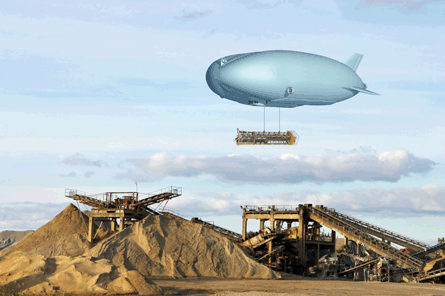London-based Hybrid Air Vehicles (HAV) expects to begin construction early next year of an airship capable of lifting 50t, with first flight scheduled for the second half of 2013.
But although the aircraft - to be built for Quebec-based speciality aviation company Discovery Air Innovations - will share a basic hybrid airship concept with the Long-Endurance Multi-intelligence Vehicle (LEMV) HAV is developing with Northrop Grumman for service from 2012, the Discovery vehicle is of a different design to meet vastly different mission objectives.
HAV business development director Hardy Giesler said the Northrop project's surveillance role dictates that the LEMV must operate at 20,000ft (6,100m) and stay aloft for 21 days, the Discovery craft will have to lift up to 50t and travel at speeds of up to 100kt (185km/h). By contrast, the LEMV is required to carry only 1t to 2t of surveillance equipment payload, plus fuel to last for three weeks.
 |
|---|
© Hybrid Air Vehicles |
Both designs are so-called hybrid airships, which gain about 60% of their lift from helium buoyancy and the rest from the shape of the hull, with extra power for take-off and landing provided by vectored thrusters. The LEMV is a double-bubble shape, like two airship hulls joined along a centreline, while the cargo version is shaped like three hulls.
Discovery has yet to complete its specification, but there are two options. One is to function like a cargo carrier, in which case it would be built with a central cargo bay. This option would, to get off the ground with its full 50t load, build forward speed like a hovercraft to gain aerodynamic lift. Hover pads on the lower surface of the two outer hulls enable the craft to glide forward on a "reasonably flat" surface. The pads' shape also provide some "suction", so the aircraft can be secured without tie-downs or other ground infrastructure.
An alternative is to configure the aircraft as a heavy lifter, to pick up or drop off large loads hanging below. Such a setup allows vertical lift, but restricts payload to 40% of the cargo variant, or about 20t with the size of vehicle Discovery has ordered. HAV envisions future developments capable of handling up to 1,000t.
Giesler said the Discovery aircraft could be built in the UK or Canada.
Airships are currently attracting a lot of attention from the US military as surveillance platforms. In addition to the LEMV, which is expected to be used in Afghanistan, the US Air Force is developing a more traditional lighter-than-air vehicle.
For civilian cargo purposes, airships offer particular capabilities as well as environmental benefits. According to HAV, by being able to operate without ground infrastructure, airships reduce or eliminate trans-shipments and save up to 75% in fuel consumption on equivalent payload alternatives. Precision hover allows pick-up and delivery of cargo from ships or other restricted locations.
Source: Flight International



















